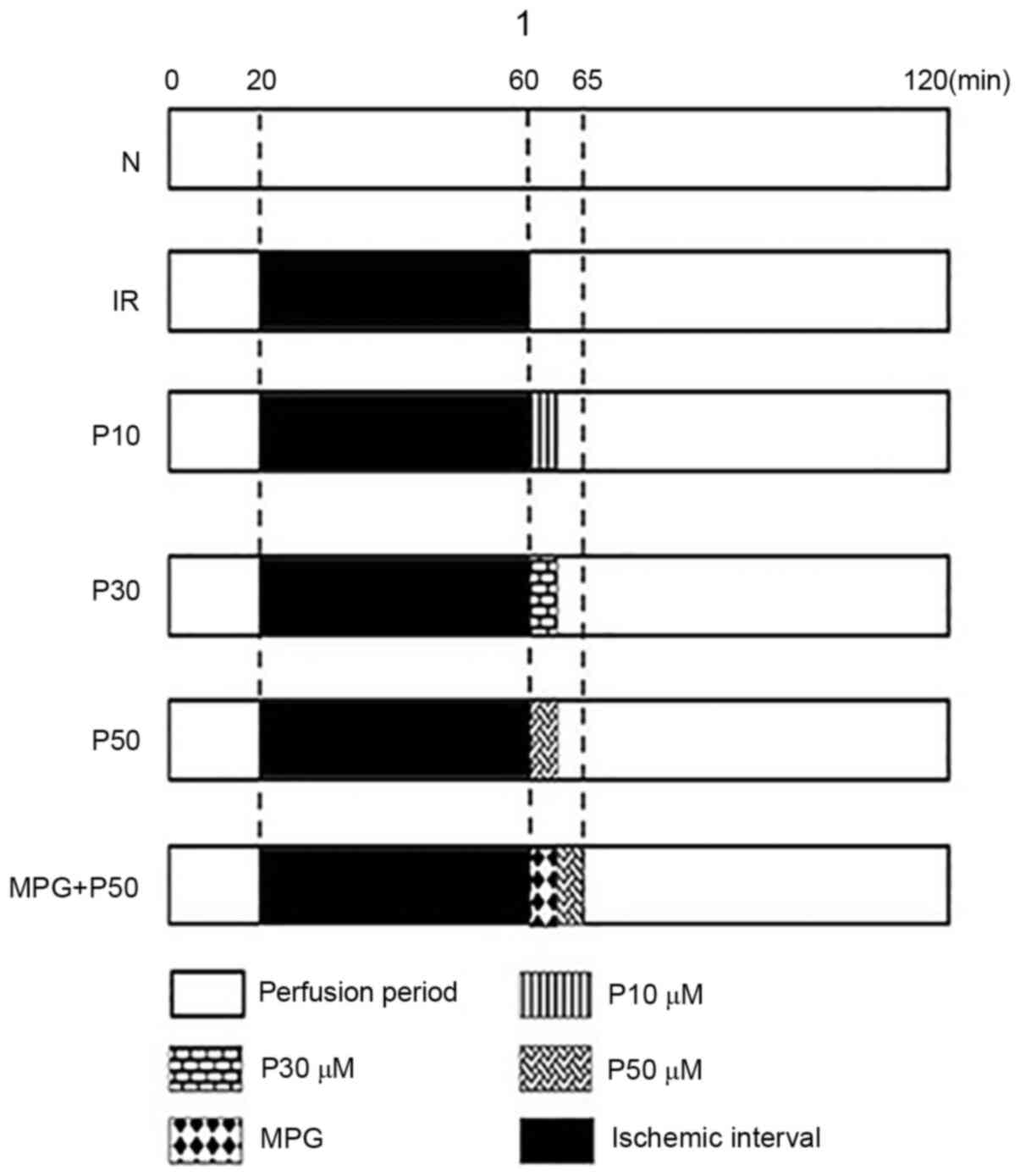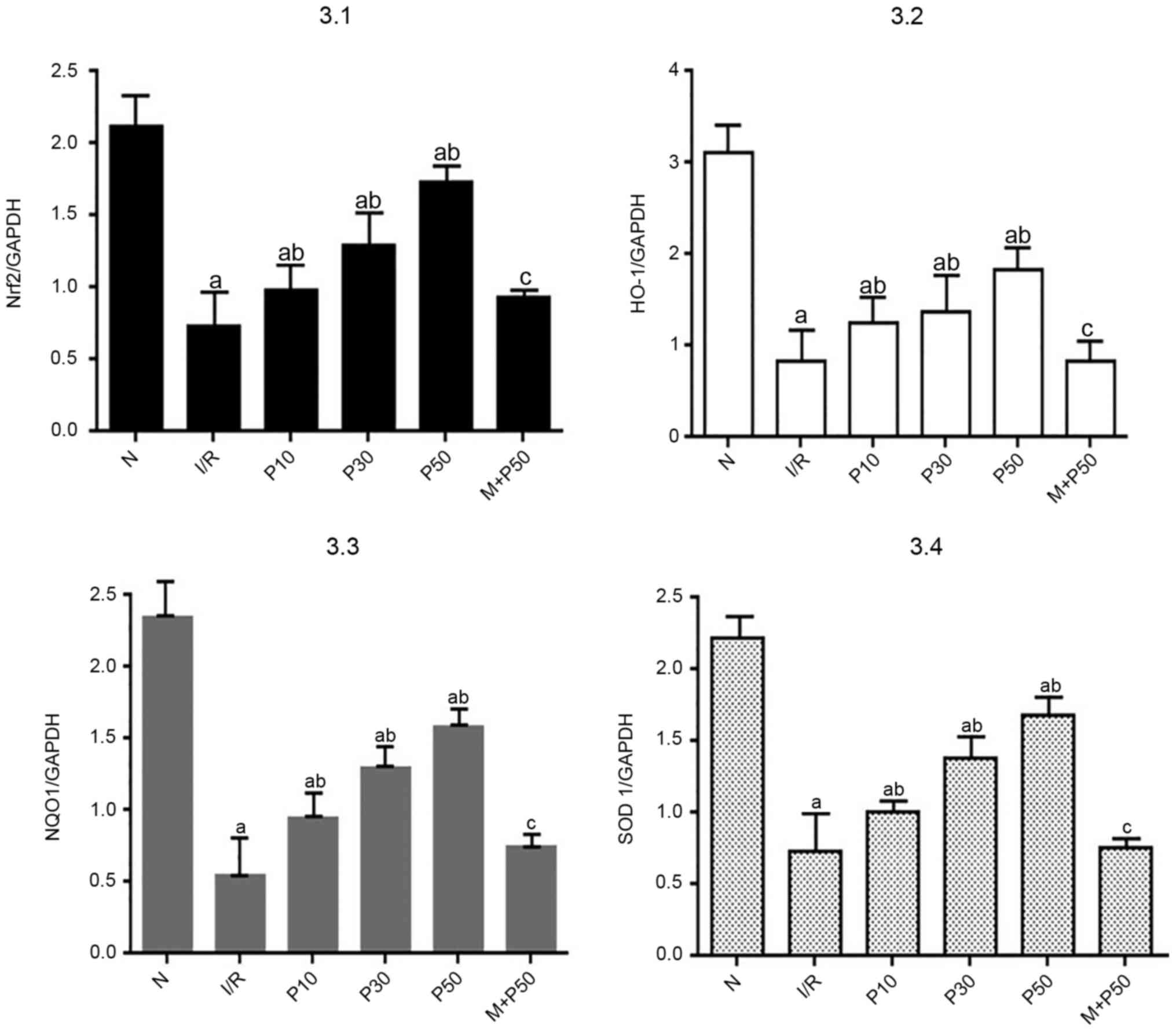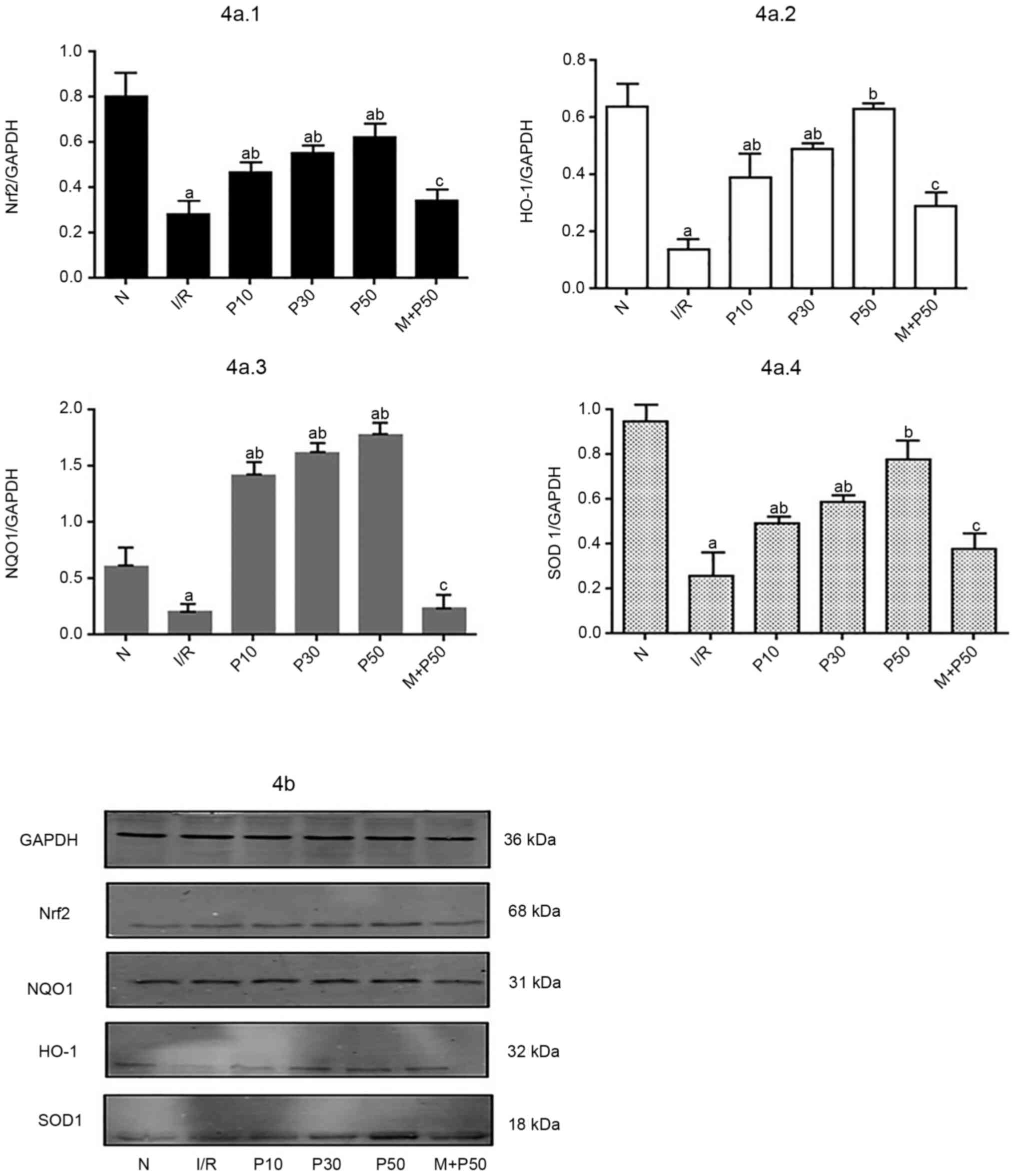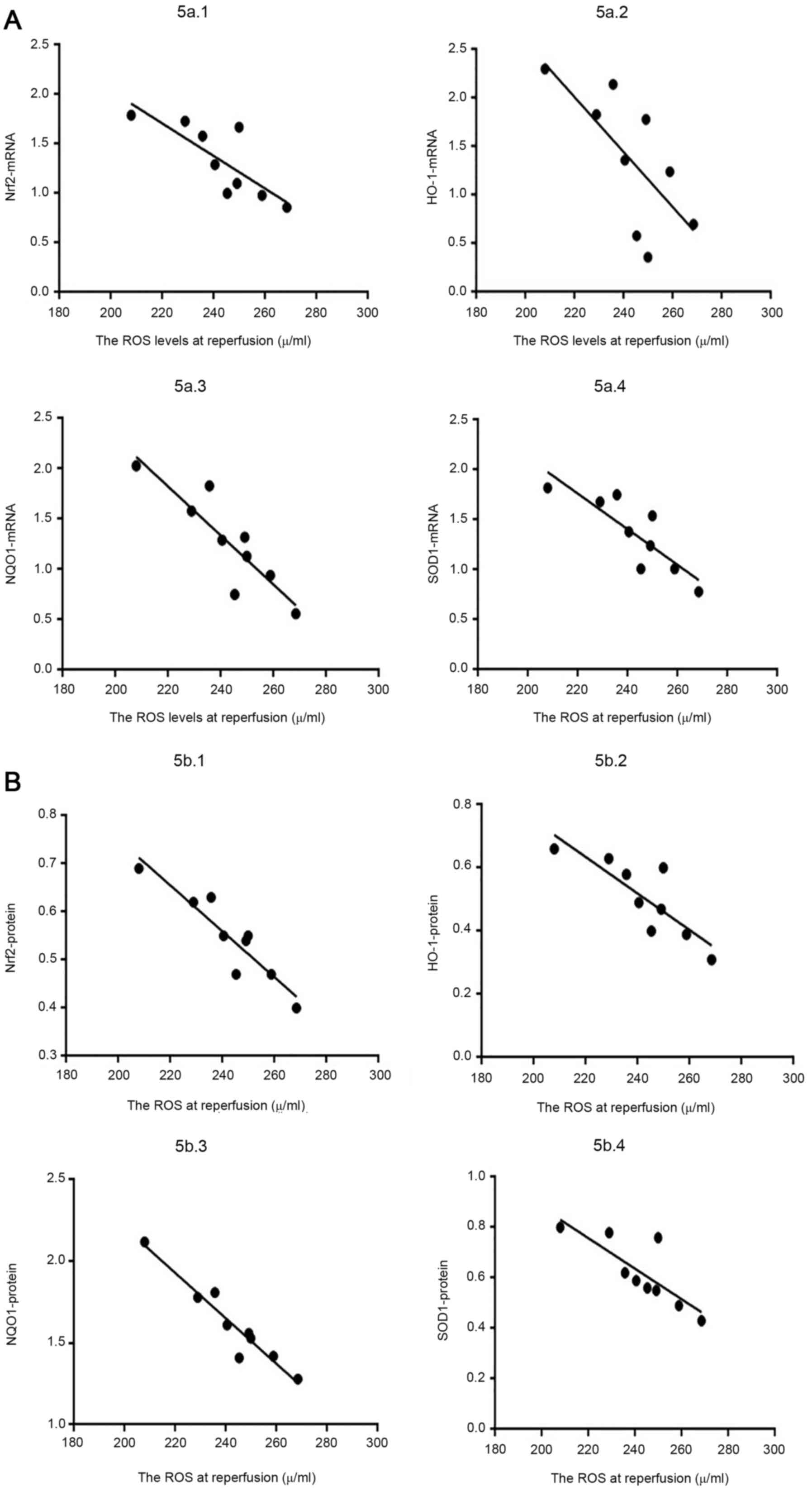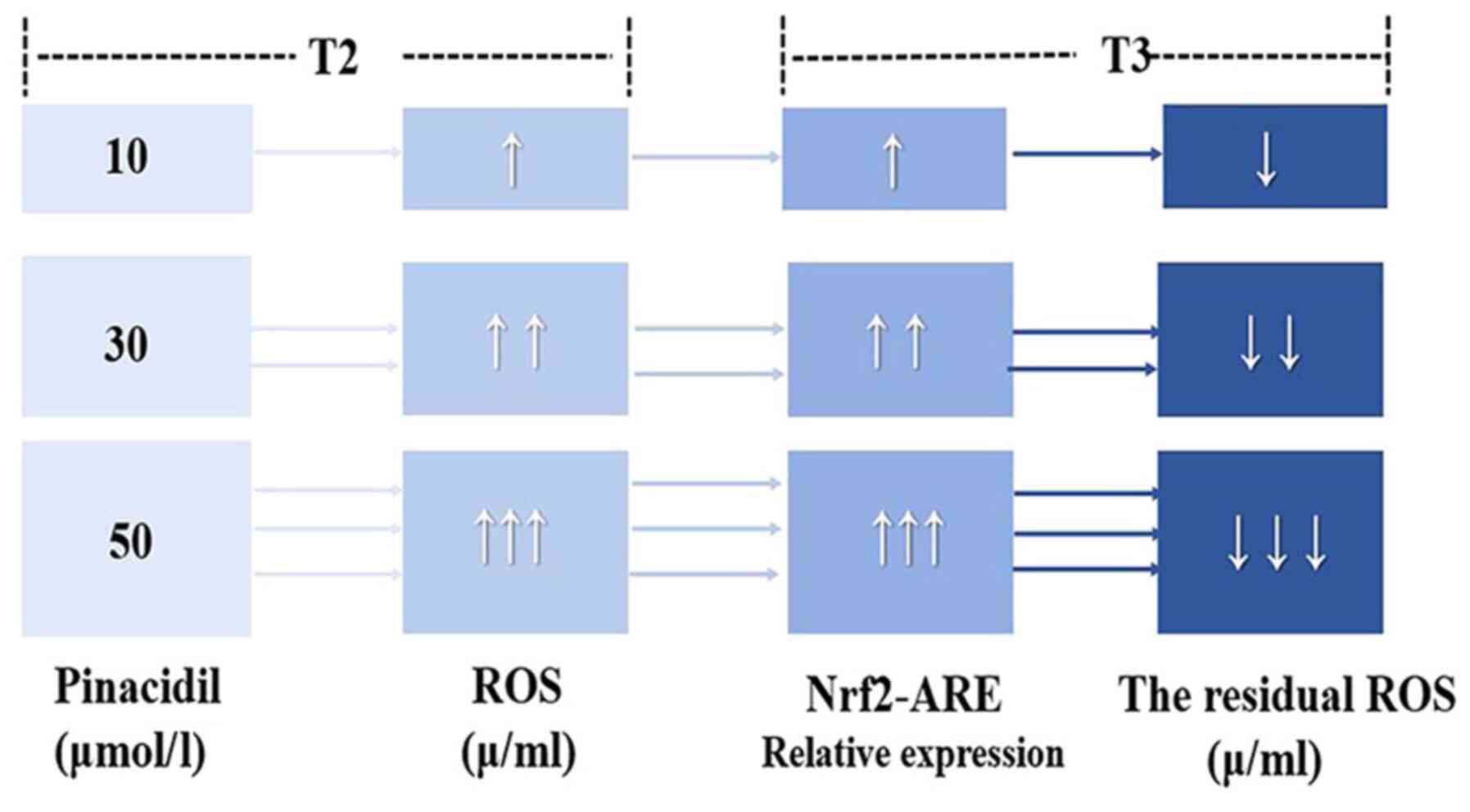|
1
|
Zhao ZQ, Corvera JS, Halkos ME, Kerendi F,
Wang NP, Guyton RA and Vinten-Johansen J: Inhibition of myocardial
injury by ischemic postconditioning during reperfusion: Comparison
with ischemic preconditioning. Am J Physiol Heart Circ Physiol.
285:H579–H588. 2003. View Article : Google Scholar
|
|
2
|
Hao M, Zhu S, Hu L, Zhu H, Wu X and Li Q:
Myocardial ischemic postconditioning promotes autophagy against
ischemia reperfusion injury via the Activation of the
nNOS/AMPK/mTOR Pathway. Int J Mol Sci. 18:6142017. View Article : Google Scholar : PubMed/NCBI
|
|
3
|
Zhang L, Cao S, Deng S, Yao G and Yu T:
Ischemic postconditioning and pinacidil suppress calcium overload
in anoxia-reoxygenation cardiomyocytes via down-regulation of the
calcium-sensing receptor. PeerJ. 4:e26122016. View Article : Google Scholar : PubMed/NCBI
|
|
4
|
Foster MN and Coetzee WA: KATP channels in
the cardiovascular system. Physiol Rev. 96:177–252. 2016.
View Article : Google Scholar : PubMed/NCBI
|
|
5
|
Cohen MV and Downey JM: Signalling
pathways and mechanisms of protection in pre- and postconditioning:
Historical perspective and lessons for the future. Br J Pharmacol.
172:1913–1932. 2015. View Article : Google Scholar : PubMed/NCBI
|
|
6
|
Yang HQ, Foster MN, Jana K, Ho J, Rindler
MJ and Coetzee WA: Plasticity of sarcolemmal KATP channel surface
expression: Relevance during ischemia and ischemic preconditioning.
Am J Physiol Heart Circ Physiol. 310:H1558–H1566. 2016. View Article : Google Scholar
|
|
7
|
Yaşar S, Bozdoğan Ö, Kaya ST and Orallar
HS: The effects of ATP-dependent potassium channel opener;
pinacidil, and blocker; glibenclamide, on the ischemia induced
arrhythmia in partial and complete ligation of coronary artery in
rats. Iran J Basic Med Sci. 18:188–193. 2015.
|
|
8
|
Yang L and Yu T: Prolonged donor heart
preservation with pinacidil: The role of mitochondria and the
mitochondrial adenosine triphosphate-sensitive potassium channel. J
Thorac Cardiovasc Surg. 139:1057–1063. 2010. View Article : Google Scholar : PubMed/NCBI
|
|
9
|
Yang YH, Zhang Y, Chen W, Wang Y, Cao S,
Yu T and Wang H: Pinacidil-postconditioning is equivalent to
ischemic postconditioning in defeating cardiac ischemia-reperfusion
injury in rat. Eur J Pharmacol. 780:26–32. 2016. View Article : Google Scholar : PubMed/NCBI
|
|
10
|
Chen X, Han K, Zhang T, Qi G, Jiang Z and
Hu C: Grass carp (Ctenopharyngodon idella) NRF2 alleviates the
oxidative stress and enhances cell viability through upregulating
the expression of HO-1. Fish Physiol Biochem. 46:417–428. 2020.
View Article : Google Scholar : PubMed/NCBI
|
|
11
|
Moon EJ and Giaccia A: Dual roles of NRF2
in tumor prevention and progression: Possible implications in
cancer treatment. Free Radic Biol Med. 79:292–299. 2015. View Article : Google Scholar : PubMed/NCBI
|
|
12
|
Patwardhan J and Bhatt P: Flavonoids
derived from abelmoschus esculentus attenuates UV-B induced cell
damage in human dermal fibroblasts through Nrf2-ARE pathway.
Pharmacogn Mag. 12 (Suppl 2):S129–S138. 2016. View Article : Google Scholar
|
|
13
|
Loboda A, Damulewicz M, Pyza E, Jozkowicz
A and Dulak J: Role of Nrf2/HO-1 system in development, oxidative
stress response and diseases: An evolutionarily conserved
mechanism. Cell Mol Life Sci. 73:3221–3247. 2016. View Article : Google Scholar : PubMed/NCBI
|
|
14
|
Bao L, Li J, Zha D, Zhang L, Gao P, Yao T
and Wu X: Chlorogenic acid prevents diabetic nephropathy by
inhibiting oxidative stress and inflammation through modulation of
the Nrf2/HO-1 and NF-κB pathways. Int Immunopharmacol. 54:245–253.
2018. View Article : Google Scholar : PubMed/NCBI
|
|
15
|
Oh ET and Park HJ: Implications of NQO1 in
cancer therapy. BMB Rep. 48:609–617. 2015. View Article : Google Scholar : PubMed/NCBI
|
|
16
|
Schlager JJ and Powis G: Cytosolic
NAD(P)H: (quinone-acceptor)oxidoreductase in human normal and tumor
tissue: Effects of cigarette smoking and alcohol. Int J Cancer.
45:403–409. 1990. View Article : Google Scholar : PubMed/NCBI
|
|
17
|
Peng Q, Lu Y, Lao X, Chen Z, Li R, Sui J,
Qin X and Li S: The NQO1 Pro187Ser polymorphism and breast cancer
susceptibility: Evidence from an updated meta-analysis. Diagn
Pathol. 9:1002014. View Article : Google Scholar : PubMed/NCBI
|
|
18
|
Zhang CY, Ren XM, Li HB, Wei W, Wang KX,
Li YM, Hu JL and Li X: Simvastatin alleviates inflammation and
oxidative stress in rats with cerebral hemorrhage through Nrf2-ARE
signaling pathway. Eur Rev Med Pharmacol Sci. 23:6321–6329.
2019.PubMed/NCBI
|
|
19
|
Feng S, Xu Z, Wang F, Yang T, Liu W, Deng
Y and Xu B: Sulforaphane prevents methylmercury-induced oxidative
damage and excitotoxicity through activation of the Nrf2-ARE
pathway. Mol Neurobiol. 54:375–391. 2017. View Article : Google Scholar : PubMed/NCBI
|
|
20
|
Zhao T, Chen S, Wang B and Cai D:
L-Carnitine reduces myocardial oxidative stress and alleviates
myocardial ischemia-reperfusion injury by activating nuclear
transcription-related factor 2 (Nrf2)/Heme Oxygenase-1 (HO-1)
signaling pathway. Med Sci Monit. 26:e9232512020. View Article : Google Scholar : PubMed/NCBI
|
|
21
|
Ma W, Liu M, Liang F, Zhao L, Gao C, Jiang
X, Zhang X, Zhan H, Hu H and Zhao Z: Cardiotoxicity of sorafenib is
mediated through elevation of ROS level and CaMKII activity and
dysregulation of calcium homoeostasis. Basic Clin Pharmacol
Toxicol. 126:166–180. 2020. View Article : Google Scholar : PubMed/NCBI
|
|
22
|
Chen W, Chen XY, Wang Y, Wang HY, Zhou WJ
and Yu T: Mechanism of emulsified isoflurane
Postconditioning-induced activation of the Nrf2-antioxidant
response element signaling pathway during myocardial
ischemia-reperfusion: The relationship with reactive oxygen
species. J Cardiovasc Pharmacol. 73:265–271. 2019. View Article : Google Scholar : PubMed/NCBI
|
|
23
|
Huang SY, Chen YC, Kao YH, Hsieh MH, Lin
YK, Chen SA and Chen YJ: Redox and activation of protein kinase a
dysregulates calcium homeostasis in pulmonary vein cardiomyocytes
of chronic kidney disease. J Am Heart Assoc. 6:e0057012017.
View Article : Google Scholar : PubMed/NCBI
|
|
24
|
Ivanova S, Batliwalla F, Mocco J, Kiss S,
Huang J, Mack W, Coon A, Eaton JW, Al-Abed Y, Gregersen PK, et al:
Neuroprotection in cerebral ischemia by neutralization of
3-aminopropanal. Proc Natl Acad Sci USA. 99:5579–5584. 2002.
View Article : Google Scholar : PubMed/NCBI
|
|
25
|
Hartung T: Comparative analysis of the
revised Directive 2010/63/EU for the protection of laboratory
animals with its predecessor 86/609/EEC-a t4 report. ALTEX.
27:285–303. 2010. View Article : Google Scholar : PubMed/NCBI
|
|
26
|
National Research Council (US) Committee
for the Update of the Guide for the Care and Use of Laboratory
Animals, . Guide for the Care and Use of Laboratory Animals. 8th
edition. National Academies Press (US); Washington, DC: 2011
|
|
27
|
Flameng W, Borgers M, Daenen W and
Stalpaert G: Ultrastructural and cytochemical correlates of
myocardial protection by cardiac hypothermia in man. J Thorac
Cardiovasc Surg. 79:413–424. 1980. View Article : Google Scholar : PubMed/NCBI
|
|
28
|
Li J, Zhou W, Chen W, Wang H, Zhang Y and
Yu T: Mechanism of the hypoxia inducible factor 1/hypoxic response
element pathway in rat myocardial ischemia/diazoxide
post-conditioning. Mol Med Rep. 21:1527–1536. 2020.PubMed/NCBI
|
|
29
|
Livak KJ and Schmittgen TD: Analysis of
relative gene expression data using real-time quantitative PCR and
the 2(-Delta Delta C(T)) method. Methods. 25:402–408. 2001.
View Article : Google Scholar : PubMed/NCBI
|
|
30
|
Hausenloy DJ, Barrabes JA, Bøtker HE,
Davidson SM, Di Lisa F, Downey J, Engstrom T, Ferdinandy P,
Carbrera-Fuentes HA, Heusch G, et al: Ischaemic conditioning and
targeting reperfusion injury: A 30 year voyage of discovery. Basic
Res Cardiol. 111:702016. View Article : Google Scholar : PubMed/NCBI
|
|
31
|
Neri M, Riezzo I, Pascale N, Pomara C and
Turillazzi E: Ischemia/Reperfusion injury following acute
myocardial infarction: A critical issue for clinicians and forensic
pathologists. Mediators Inflamm. 2017:70183932017. View Article : Google Scholar : PubMed/NCBI
|
|
32
|
Tsutsumi YM, Yokoyama T, Horikawa Y, Roth
DM and Patel HH: Reactive oxygen species trigger ischemic and
pharmacological postconditioning: In vivo and in vitro
characterization. Life Sci. 81:1223–1227. 2007. View Article : Google Scholar : PubMed/NCBI
|
|
33
|
Granger DN and Kvietys PR: Reperfusion
injury and reactive oxygen species: The evolution of a concept.
Redox Biol. 6:524–551. 2015. View Article : Google Scholar : PubMed/NCBI
|
|
34
|
Pisarenko O, Shulzhenko V, Studneva I,
Pelogeykina Y, Timoshin A, Anesia R, Valet P, Parini A and
Kunduzova O: Structural apelin analogues: Mitochondrial ROS
inhibition and cardiometabolic protection in myocardial ischaemia
reperfusion injury. Br J Pharmacol. 172:2933–2945. 2015. View Article : Google Scholar : PubMed/NCBI
|
|
35
|
Han J, Kim N, Park J, Seog DH, Joo H and
Kim E: Opening of mitochondrial ATP-sensitive potassium channels
evokes oxygen radical generation in rabbit heart slices. J Biochem.
131:721–727. 2002. View Article : Google Scholar : PubMed/NCBI
|
|
36
|
Zi C, Zhang C, Yang Y and Ma J:
Penehyclidine hydrochloride protects against anoxia/reoxygenation
injury in cardiomyocytes through ATP-sensitive potassium channels,
and the Akt/GSK-3β and Akt/mTOR signaling pathways. Cell Biol Int.
44:1353–1362. 2020. View Article : Google Scholar : PubMed/NCBI
|
|
37
|
Fan Z, Wen T, Chen Y, Huang L, Lin W, Yin
C and Tan W: Isosteviol sensitizes sarcKATP channels towards
pinacidil and potentiates mitochondrial uncoupling of diazoxide in
guinea pig ventricular myocytes. Oxid Med Cell Longev.
2016:63628122016. View Article : Google Scholar : PubMed/NCBI
|
|
38
|
Liang W, Chen J, Mo L, Ke X, Zhang W,
Zheng D, Pan W, Wu S, Feng J, Song M and Liao X: ATP-sensitive K+
channels contribute to the protective effects of exogenous hydrogen
sulfide against high glucose-induced injury in H9c2 cardiac cells.
Int J Mol Med. 37:763–772. 2016. View Article : Google Scholar : PubMed/NCBI
|
|
39
|
Slove S, Lannoy M, Behmoaras J, Pezet M,
Sloboda N, Lacolley P, Escoubet B, Buján J and Jacob MP: Potassium
channel openers increase aortic elastic fiber formation and reverse
the genetically determined elastin deficit in the BN rat.
Hypertension. 62:794–801. 2013. View Article : Google Scholar : PubMed/NCBI
|
|
40
|
Tanonaka K, Iwai T, Motegi K and Takeo S:
Effects of N-(2-mercaptopropionyl)-glycine on mitochondrial
function in ischemic-reperfused heart. Cardiovasc Res. 57:416–425.
2003. View Article : Google Scholar : PubMed/NCBI
|
|
41
|
Andreadou I, Iliodromitis EK, Souridis V,
Prokovas E, Kostidis S, Zoga A, Dagres N, Tsantili-Kakoulidou A,
Kremastinos DT, Mikros E and Anastasiou-Nana M: Investigating the
effect of antioxidant treatment on the protective effect of
preconditioning in anesthetized rabbits. J Cardiovasc Pharmacol.
58:609–166. 2011. View Article : Google Scholar : PubMed/NCBI
|
|
42
|
Fantinelli JC, González ALF, Pérez NIA and
Mosca SM: Protective effects of N-(2-mercaptopropionyl)-glycine
against ischemia-reperfusion injury in hypertrophied hearts. Exp
Mol Pathol. 94:277–284. 2013. View Article : Google Scholar : PubMed/NCBI
|
|
43
|
Ihnken K, Morita K, Buckberg GD, Sherman
MP and Young HH: Studies of hypoxemic/reoxygenation injury: Without
aortic clamping. VI. Counteraction of oxidant damage by exogenous
antioxidants: N-(2-mercaptopropionyl)-glycine and catalase. J
Thorac Cardiovasc Surg. 110:1212–1220. 1995. View Article : Google Scholar : PubMed/NCBI
|
|
44
|
Shanmugam G, Narasimhan M, Tamowski S,
Darley-Usmar V and Rajasekaran NS: Constitutive activation of Nrf2
induces a stable reductive state in the mouse myocardium. Redox
Biol. 12:937–945. 2017. View Article : Google Scholar : PubMed/NCBI
|
|
45
|
Buelna-Chontal M, Guevara-Chávez JG,
Silva-Palacios A, Medina-Campos ON, Pedraza-Chaverri J and Zazueta
C: Nrf2-regulated antioxidant response is activated by protein
kinase C in postconditioned rat hearts. Free Radic Biol Med.
74:145–156. 2014. View Article : Google Scholar : PubMed/NCBI
|
|
46
|
Zai CC, Tiwari AK, Basile V, de Luca V,
Müller DJ, Voineskos AN, Remington G, Meltzer HY, Lieberman JA,
Potkin SG and Kennedy JL: Oxidative stress in tardive dyskinesia:
Genetic association study and meta-analysis of NADPH quinine
oxidoreductase 1 (NQO1) and Superoxide dismutase 2 (SOD2, MnSOD)
genes. Prog Neuropsychopharmacol Biol Psychiatry. 34:50–56. 2010.
View Article : Google Scholar : PubMed/NCBI
|
|
47
|
Gang GT, Hwang JH, Kim YH, Noh JR, Kim KS,
Jeong JY, Choi DE, Lee KW, Jung JY, Shong M and Lee CH: Protection
of NAD(P)H:quinone oxidoreductase 1 against renal
ischemia/reperfusion injury in mice. Free Radic Biol Med.
67:139–149. 2014. View Article : Google Scholar : PubMed/NCBI
|
|
48
|
Chen G, Fang Q, Zhang J, Zhou D and Wang
Z: Role of the Nrf2-ARE pathway in early brain injury after
experimental subarachnoid hemorrhage. J Neurosci Res. 89:515–523.
2011. View Article : Google Scholar : PubMed/NCBI
|
|
49
|
Freixa X, Bellera N, Ortiz-Pérez JT,
Jiménez M, Paré C, Bosch X, De Caralt TM, Betriu A and Masotti M:
Ischaemic postconditioning revisited: Lack of effects on infarct
size following primary percutaneous coronary intervention. Eur
Heart J. 33:103–112. 2012. View Article : Google Scholar : PubMed/NCBI
|
|
50
|
Limalanathan S, Andersen GØ, Kløw NE,
Abdelnoor M, Hoffmann P and Eritsland J: Effect of ischemic
postconditioning on infarct size in patients with ST-elevation
myocardial infarction treated by primary PCI results of the POSTEMI
(POstconditioning in ST-Elevation Myocardial Infarction) randomized
trial. J Am Heart Assoc. 3:e0006792014. View Article : Google Scholar : PubMed/NCBI
|
|
51
|
Paul MK, Bisht B, Darmawan DO, Chiou R, Ha
VL, Wallace WD, Chon AT, Hegab AE, Grogan T, Elashoff DA, et al:
Dynamic changes in intracellular ROS levels regulate airway basal
stem cell homeostasis through Nrf2-dependent Notch signaling. Cell
Stem Cell. 15:199–214. 2014. View Article : Google Scholar : PubMed/NCBI
|
|
52
|
Rojo de la Vega M, Chapman E and Zhang DD:
NRF2 and the hallmarks of cancer. Cancer Cell. 34:21–43. 2018.
View Article : Google Scholar : PubMed/NCBI
|
|
53
|
Kensler TW, Wakabayashi N and Biswal S:
Cell survival responses to environmental stresses via the
Keap1-Nrf2-ARE pathway. Annu Rev Pharmacol Toxicol. 47:89–116.
2007. View Article : Google Scholar : PubMed/NCBI
|
|
54
|
Ma Q: Role of nrf2 in oxidative stress and
toxicity. Annu Rev Pharmacol Toxicol. 53:401–426. 2013. View Article : Google Scholar : PubMed/NCBI
|
|
55
|
Jaramillo MC and Zhang DD: The emerging
role of the Nrf2-Keap1 signaling pathway in cancer. Genes Dev.
27:2179–2191. 2013. View Article : Google Scholar : PubMed/NCBI
|
|
56
|
Harder B, Jiang T, Wu T, Tao S, Rojo de la
Vega M, Tian W, Chapman E and Zhang DD: Molecular mechanisms of
Nrf2 regulation and how these influence chemical modulation for
disease intervention. Biochem Soc Trans. 43:680–686. 2015.
View Article : Google Scholar : PubMed/NCBI
|
|
57
|
Iguchi K, Saotome M, Yamashita K, Hasan P,
Sasaki M, Maekawa Y and Watanabe Y: Pinacidil, a KATP channel
opener, stimulates cardiac Na+/Ca2+ exchanger
function through the NO/cGMP/PKG signaling pathway in guinea pig
cardiac ventricular myocytes. Naunyn Schmiedebergs Arch Pharmacol.
392:949–959. 2019. View Article : Google Scholar : PubMed/NCBI
|
|
58
|
Itoh K, Chiba T, Takahashi S, Ishii T,
Igarashi K, Katoh Y, Oyake T, Hayashi N, Satoh K, Hatayama I, et
al: An Nrf2/small Maf heterodimer mediates the induction of phase
II detoxifying enzyme genes through antioxidant response elements.
Biochem Biophys Res Commun. 236:313–322. 1997. View Article : Google Scholar : PubMed/NCBI
|
|
59
|
Satta S, Mahmoud AM, Wilkinson FL, Yvonne
AM and White SJ: The role of Nrf2 in cardiovascular function and
disease. Oxid Med Cell Longev. 2017:92372632017. View Article : Google Scholar : PubMed/NCBI
|
|
60
|
Penna C, Rastaldo R, Mancardi D, Raimondo
S, Cappello S, Gattullo D, Losano G and Pagliaro P:
Post-conditioning induced cardioprotection requires signaling
through a redox-sensitive mechanism, mitochondrial ATP-sensitive K+
channel and protein kinase C activation. Basic Res Cardiol.
101:180–189. 2006. View Article : Google Scholar : PubMed/NCBI
|
|
61
|
Shoujia Y, Haiying W, Tian Y and Xingkui
L: The role of Nrf2-ARE pathway in hypoxia/pinacidil post-treatment
in reducing hypoxia-reoxygenation injury of rat cardiomyocytes.
Chin J Pathophysiology. 1696–1699, +1703. 2013.
|















